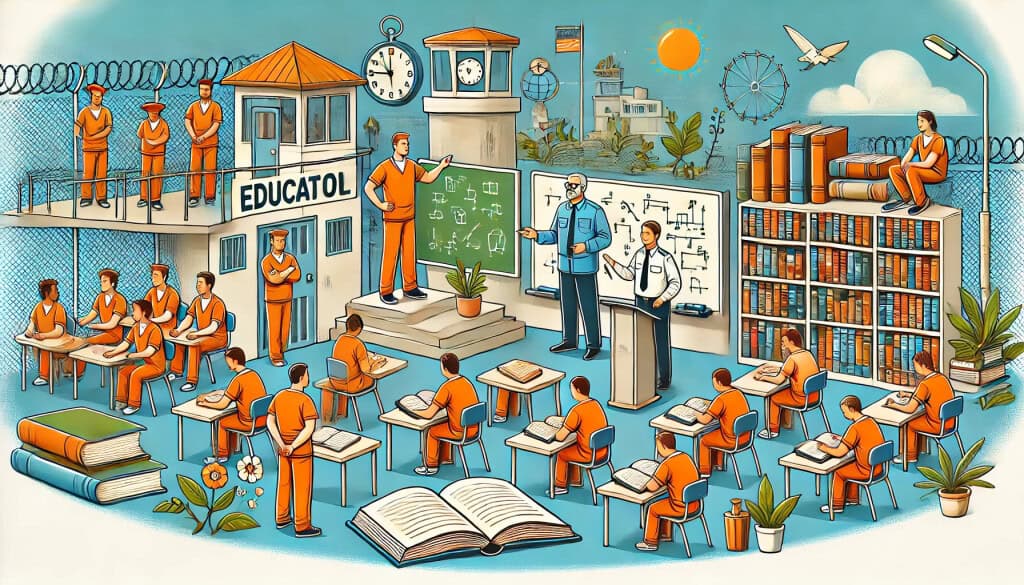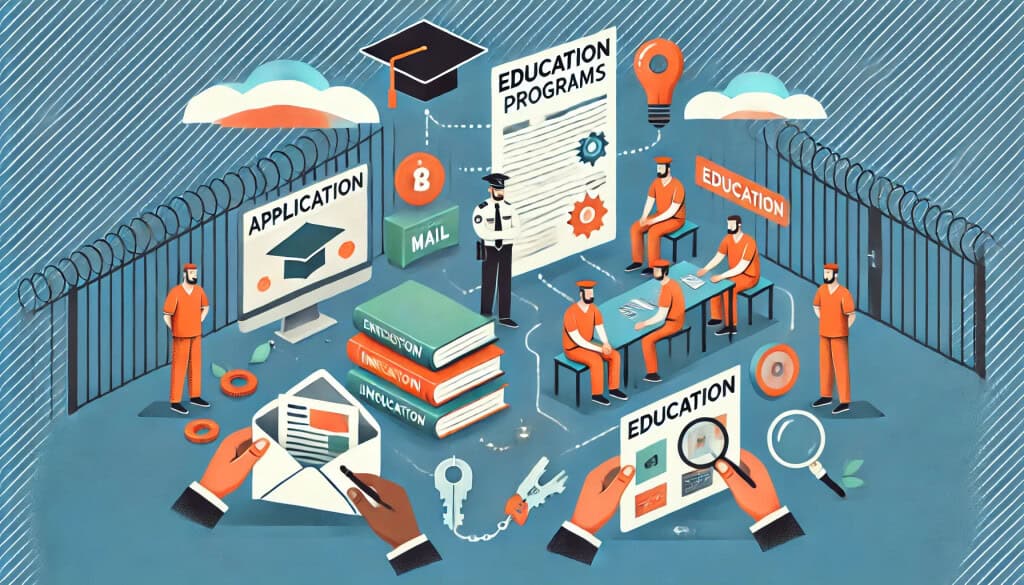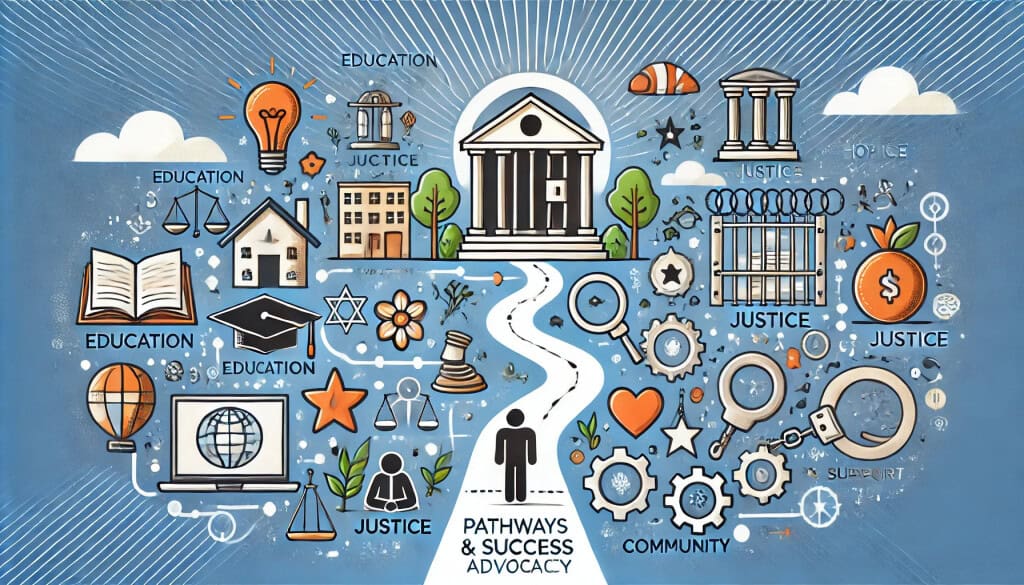For incarcerated individuals, education can be a lifeline to a better future. Studies have shown that expanding access to education in prison improves the chances of securing a job upon release, which in turn lowers recidivism and helps people become productive, tax-paying citizens1.
Below, we share personal success stories of formerly incarcerated people who transformed their lives through prison education programs. We then explore the educational opportunities available to those currently in Georgia’s prisons – from GED courses to college degrees, including programs like Ashland University’s prison degree initiative, correspondence courses by mail, and other in-prison college options. Finally, we provide practical instructions on how incarcerated learners can enroll and take advantage of these programs.
Success Stories of Second Chances Through Education

From GED to PhD: One Man’s Journey
Aaron Kinzel’s story shows how a basic education behind bars can spark an academic journey. As a teenager incarcerated in Maine, Aaron earned his GED while awaiting trial – thanks to a dedicated teacher who ran a GED prep class in the jail1. He went on to serve a 19-year prison sentence during which he took vocational training and even some college-level courses. After release, Aaron was determined to continue his education. He enrolled in college, eventually earning both an associate and a bachelor’s degree with honors, and later a master’s degree in public administration.
Despite the barriers of a serious felony record, he persisted and found support from mentors. Today, Aaron is a university lecturer in criminal justice and is pursuing his doctorate – a role he could hardly imagine when he first entered prison. He credits the education he received for giving him “the knowledge, confidence, work ethic and leadership skills” to overcome reentry challenges and build a new life1. His transformation illustrates that earning a GED in prison can be the first step toward a professional career – in his case, from inmate to college professor.
Coding Behind Bars: From Prison Training to Tech Career
Not all prison education is purely academic – vocational and skills-based programs can directly lead to jobs. David Evans spent 14 years in Georgia prisons, where he joined two programs that changed his life. The first was Common Good Atlanta, a volunteer-led college-level liberal arts program that opened his mind and even helped him get several pieces of writing published. The second was Hello World, one of the few prison programs teaching computer programming to inmates. Through Hello World’s coding classes, David learned valuable tech skills.
As a result of this training, he was able to become a freelance software developer working from home after his release2. In his own words, these education programs helped him “walk out of the proverbial Plato’s Cave” and gain marketable skills. David’s story shows how vocational courses (like computer programming, welding, carpentry, etc.) offered in prison can translate into real-world employment. With the demand for skilled workers, an inmate who learns a trade or tech skill stands a much better chance of finding stable, decent-paying work once free.
A College Degree Behind Bars Leads to a New Career
Earning a college degree in prison is challenging, but it can be truly life-changing. Take the story of Benito Castro. In 2014, Benito was sentenced to six years in prison for a non-violent offense related to a gambling addiction. While incarcerated, he enrolled in Ashland University’s correctional education program and earned a college degree before he was released3. That education became the springboard for his reintegration. After release, Benito started at an entry-level job as a restaurant dishwasher. He soon impressed an employer in the grocery industry and worked his way up the ladder – from night manager to marketing director to director of operations for a grocery store chain. He even founded a nonprofit, Freedom Rides, to help other newly released people with transportation.
Benito explicitly credits the Ashland University prison education program for his transformation, saying that earning his degree “made all the difference in the world” and gave him purpose3. With financial security and self-respect, he now contributes positively to society. His success is a powerful example of how a college diploma earned behind bars can open doors: employers took notice of his credentials and initiative, allowing him to build a stable career he might never have had otherwise.
These narratives – and many others like them – demonstrate that education can empower incarcerated people to rebuild their lives. Whether it starts with a high school equivalency, a vocational certificate, or a college degree, learning new skills and knowledge in prison often translates to confidence, employability, and further educational pursuits after release. In short, education helps turn a prison sentence into a second chance.
Educational Opportunities for Georgia Prisoners

Georgia has been actively expanding access to educational programs for those behind bars. In recent years, several initiatives and partnerships have made it possible for inmates in Georgia to earn credentials from GEDs to college degrees while serving time. Here are some of the prominent programs and opportunities available:
- General Education (GED and High School): Every Georgia state prison offers adult basic education and GED preparation classes. Incarcerated individuals who have not finished high school are encouraged to obtain a GED diploma through classes and tutoring offered on-site. Earning a GED is often the first required step before pursuing higher education programs in prison. Many facilities even host formal GED graduation ceremonies, underscoring the importance of this accomplishment. (In Georgia, some younger inmates can also earn a standard high school diploma through special programs, though GED is more common for adults.)
- Ashland University Associate Degree (Second Chance Pell Program): Georgia’s Department of Corrections partnered with Ashland University to offer an Associate of Arts degree in General Studies to qualified inmates. Launched in 2018 at facilities like Whitworth Women’s Facility, Dooly State Prison, and Smith State Prison, this program is funded by the federal Second Chance Pell Grant and had an initial cohort of 150 inmate-students enrolled4. Ashland University (based in Ohio) operates the largest prison college program in the nation, with over 4,000 incarcerated students across more than a dozen states, and provides tablets (through a secure system called Lantern) for students to access coursework3. In Georgia, Ashland’s program allows inmates who meet academic and conduct criteria to take college courses and earn an accredited associate degree while in custody. The cost is covered by Pell Grants for those eligible, making it free to the student and at no cost to the prison. This is a key opportunity for Georgia inmates in participating facilities to get a two-year college degree behind bars.
- Georgia State University Prison Education Project (GSUPEP): Home-grown in Georgia, GSU’s Prison Education Project offers for-credit college courses and degree pathways in select state prisons. Notably, Georgia State (Perimeter College) offers an Associate degree program at Phillips State Prison and at Walker State Prison (both men’s facilities) through partnerships with Common Good Atlanta5. In these programs, inmates enroll as GSU students and take courses toward an Associate of Arts degree, with instructors often being GSU faculty who teach on-site. GSUPEP also provides credit-bearing classes at Whitworth Women’s Facility (in cooperation with another nonprofit, Reforming Arts) and non-credit enrichment courses at other correctional facilities and transition centers. In essence, incarcerated students in these programs can earn college credit – and even complete an associate degree – while in prison, positioning them to continue into bachelor’s programs after release.
- Life University’s “Chillon Project”: Life University (based in Marietta, GA) launched the Chillon Project in 2016, which brings degree programs into Arrendale State Prison, Georgia’s largest women’s prison. Through this initiative, women at Arrendale can earn an Associate of Arts in Positive Human Development and Social Change, and now a Bachelor of Science in Psychology, all through Life University’s accredited curriculum5. The program also includes some correctional staff as students. This gives women in prison a chance to attain college degrees in fields that can lead to careers in counseling, social work, or other human service roles post-release. The Chillon Project is another Second Chance Pell Grant site, meaning eligible students have their tuition covered. It has been recognized as a model for providing higher education in a women’s facility.
- Brewton-Parker College Programs: Brewton-Parker College, a private college in Georgia, became a Second Chance Pell partner in 2019. Through an effort called the Philemon Fellowship, Brewton-Parker faculty have been offering credit-bearing college classes at Wheeler Correctional Facility and Johnson State Prison (both men’s institutions). These classes enable inmates to work toward degree requirements with the option to earn an Associate or Bachelor’s degree through Brewton-Parker over time5. This program often focuses on liberal arts and ministry-related education, reflecting Brewton-Parker’s Christian college background, though it provides a solid academic foundation applicable to many paths.
- University of West Georgia (UWG): The University of West Georgia has recently started offering classes at Hays State Prison as part of its mission to reduce recidivism through education. Incarcerated students at Hays can take courses that count toward a Bachelor of Interdisciplinary Studies degree, with a curriculum designed to prepare them for in-demand careers and for roles where their lived experience can be an asset6. UWG professors teach courses on-site, and inmates earn transferable credit. This program is newer but represents the growing involvement of Georgia’s public universities in prison education.
- Common Good Atlanta (Volunteer-led Classes): Common Good Atlanta is a nonprofit that has been connecting professors from various Georgia colleges to teach in prisons since 2008. While not a college itself, Common Good Atlanta provides college-level humanities and writing classes in several Georgia prisons and transitional centers, creating a classroom experience where incarcerated students engage with literature, history, science, and more. Alumni of Common Good Atlanta (like David Evans mentioned earlier) have gone on to publish writings and succeed in careers. The program’s courses are not always credit-bearing (unless done in partnership with schools like GSU), but they offer rigorous education and often inspire participants to pursue formal degrees. Common Good Atlanta essentially lays the groundwork so that when formal opportunities (like GSU or other degree programs) become available, inmates are ready to thrive.
- Correspondence Courses (College by Mail): For those in prisons where in-person or tablet-based college programs are not available, print-based correspondence courses are a vital alternative. A number of accredited universities still offer “distance learning” by mail, allowing prisoners anywhere to enroll in courses and even earn degrees through the postal service. For example, Adams State University in Colorado operates a Prison College Program that specializes in print-based correspondence education nationwide – offering certificates, associate’s, bachelor’s, and even master’s degrees to inmates who study through the mail7. Other schools that have long-running mail correspondence programs for prisoners include Colorado State University–Pueblo (independent study courses), Ohio University (print-based outreach courses), and Andrews University, among others. These programs typically require the student (or their family) to pay tuition or secure financial aid, but they open the door for motivated individuals to earn recognized college credits or diplomas from inside their cell. Georgia’s prisons do allow inmates to sign up for correspondence courses; for instance, Burruss Correctional Training Center lists “Correspondence Courses” among its academic programs for inmates. If an inmate can afford the fees (or now, potentially use federal Pell Grants as they become available to incarcerated students nationally), correspondence study is a flexible way to get an education even if no formal classroom is available. The trade-off is that it requires strong self-discipline – students must do coursework independently and send assignments to professors by mail – but many have succeeded this way.
Bottom line: In Georgia, incarcerated individuals have more educational opportunities than ever before. They can work toward a GED, learn a trade, or even earn college degrees while still serving their sentences. Programs like Ashland University’s associate degree, GSU’s and Life University’s in-prison classes, and nationwide correspondence courses by mail provide multiple pathways for those behind bars to invest in themselves. These opportunities not only benefit the individuals (making them more employable and better prepared for reentry), but also contribute to safer communities – education is proven to reduce recidivism, meaning educated ex-offenders are less likely to return to crime8.
How Prisoners Can Enroll in Education Programs

For incarcerated people in Georgia (or their families supporting them), navigating how to sign up for these programs can be daunting. Here are some practical steps and tips to enroll in prison education programs:
- Start with a GED or High School Diploma: If you don’t already have a high school credential, enroll in the prison’s GED classes first. A GED or diploma is usually required to join any higher education or vocational program. Prison education staff can administer practice tests and schedule the official GED exam when you’re ready. Reaching this milestone will unlock the door to college-level programs.
- Talk to the Prison’s Education Coordinator: Every facility has a counselor or education coordinator who oversees inmate programs. Submit a request or sign up for an appointment to discuss your interest in further education. Ask what programs are currently offered at your prison. The coordinator can tell you if your facility has partnerships with any colleges (like Ashland or a state university) or if vocational courses are available. They can also advise what criteria you need to meet (for example, some programs require being infraction-free for a period or within a certain number of years to release/parole eligibility). Make sure you express your eagerness to learn – sometimes there may be waitlists or limited slots, but persistence and positive behavior can improve your chances.
- Apply for In-Prison College Programs: If your prison offers a degree program (such as the Ashland associate degree or a Georgia State University course), you will typically need to fill out an application or interest form. Program staff might hold an orientation or send applications to those who qualify. Follow all instructions carefully – you may need to write a statement of interest or take placement tests. If the program is funded by Pell Grants, you’ll also need to complete a FAFSA (Free Application for Federal Student Aid), which the education staff can help with. Once accepted, you’ll be enrolled as a student of that college. Classes might be conducted in a prison classroom or via tablet, depending on the program. Tip: Take it seriously – attendance and homework are just as important as on a campus, and you’ll need to manage your time with whatever prison job or duties you have. But remember, doing well can earn you credentials that no one can take away.
- Enrolling in Correspondence Courses: If no formal college program is available at your facility, you can study through the mail on your own initiative. This will require some outside coordination. Here’s how to get started:
- Research available programs: You or a family member should identify accredited schools that offer prison correspondence courses. As mentioned, Adams State University’s Prison Education Program is a popular choice (they offer printable information online). You can also request a list of programs from the prison library or education department – they often have addresses of schools.
- Request an application/catalog: Write a letter to the school’s prison program office requesting an admissions packet or course catalog. (Family on the outside can often fill out an online form or send an email on your behalf to request info – for example, Adams State lets family members fill out a form to have a catalog mailed to an inmate’s address9.) Provide your name, ID number, and address exactly as required by your facility’s mail rules. Once you receive the catalog or forms, review the courses and fees.
- Secure funding: Correspondence courses usually require payment for tuition and books. Some inmates pay with itsy bitsy earnings or help from family. Starting in July 2023, federal Pell Grants are fully reinstated for incarcerated students, so you might be able to get financial aid – check if the school participates in Pell for inmates. Otherwise, you might take one course at a time that you can afford. Sometimes, scholarships or sponsorships are available for prisoners (organizations like Prison Scholars Fund or your prison’s education foundation might assist).
- Enroll and study: Complete the registration form for the course or program you want, and mail it back with payment or financial aid info. Once enrolled, the school will mail you textbooks, study guides, and assignments. You will complete the readings and written assignments, then mail your work to instructors for grading. Stay disciplined and stick to a schedule – without a teacher physically present, it’s on you to budget your study time. Utilize any quiet time (evenings or weekends) to do the coursework. If you run into difficulties, write to your instructor; some programs allow monitored phone calls with academic advisors too.
- Take exams under supervision: Many correspondence courses require proctored exams. Your prison education office can usually proctor these tests. Coordinate with them when you’re ready to take an exam – they’ll receive the exam materials from the school, administer the test, and send it back for grading.
- By following through, you can accumulate credits and even finish a degree. It’s a marathon, not a sprint – but many prisoners have earned associate or bachelor’s degrees by mail, proving it can be done.
- Explore Vocational and Certificate Programs: Academic degrees aren’t the only path. Georgia’s prisons offer many vocational training programs (welding, automotive, building trades, culinary arts, computer skills, barbering, and more). Ask the education or vocational counselor what’s available at your facility. Enrollment might be limited, but if you show genuine interest and aptitude, you could get a spot. These programs often run a few months to a year and provide you with a certificate or technical credential upon completion. For example, earning a welding certification or a barber’s license in prison can directly lead to jobs on the outside. Treat these programs like a real class – attend every session, practice diligently, and keep any certificates you earn in a safe place. They become part of your portfolio for reentry. Also, take advantage of shorter courses like OSHA safety certification, ServSafe food handling, or forklift operation if offered – these add to your employability.
- Utilize the Prison Library and Free Resources: If formal programs are limited, remember that self-education is always an option. Prison libraries often have GED prep books, vocational manuals, and even college textbooks. Independent study groups sometimes form among inmates – for example, to practice math or language skills. In addition, you can ask family outside to help get educational books or even print out materials. Massive Open Online Courses (MOOCs) are free online classes from major universities; obviously, you can’t go on the internet in prison, but a family member could download course lectures, assignments, or articles and mail them to you. In fact, as we discussed in a previous article, MOOCs can empower prisoners and their families to learn together by sharing materials through the mail10. While you might not get formal credit this way, you can gain knowledge in anything from coding to business to art history. Showing that initiative can keep your mind sharp and even impress parole boards or future employers.
- Plan for Continuity: Whatever education you start in prison, try to continue your learning upon release. If you earned some college credits, follow up with the institution or a local college to transfer into a program in the community. If you got a vocational certificate, use the reentry services (or WorkSource offices) to connect with employers in that trade. Georgia has reentry organizations that can help released individuals with job placement, apprenticeships, or college admissions. Don’t be shy about your accomplishments – list your education and certificates on your résumé. There are also networks like the Formerly Incarcerated College Graduates Network that offer support and mentorship to people who went to school during or after incarceration11. Education is a lifelong journey, and release is when you truly get to apply the skills and credentials you worked so hard for.
Conclusion

For those in Georgia’s prisons, the road from a cell to a classroom is not easy, but it is more accessible now than it has been in decades. Whether it’s earning a GED, learning a trade, or getting a college degree, pursuing education behind bars is one of the most effective ways to ensure a successful reentry. The personal stories of triumph – individuals who have gone from prison students to community leaders – prove that investment in education pays off. If you have a loved one incarcerated, encourage them to explore these opportunities. And if you are incarcerated reading this (perhaps through a family member’s letter, wink-wink), know that your past does not have to define your future. With knowledge and skills gained through education, you can write a new chapter of your life story when you return home. As one prison college graduate told us, “Education gave me back my self-worth and a future to work toward” – and that is a freedom no prison can take away.
About Pathways to Success and Georgia Prisoners Speak (GPS)

At Georgia Prisoners Speak (GPS), we believe that education is one of the most powerful tools for breaking cycles of incarceration and building a better future. That’s why we created the Pathways to Success program—a dedicated initiative providing educational resources, skill-building guides, and financial literacy tools tailored specifically for prisoners and their families.
GPS is a prison reform advocacy platform focused on exposing systemic injustices, pushing for policy change, and empowering incarcerated individuals with the knowledge they need to successfully re-enter society. Our educational articles are part of this mission, ensuring that those impacted by incarceration have access to practical guidance that can help them build stability, opportunity, and financial independence.
To explore more resources, visit Pathways to Success.
Endnotes:
Footnotes- https://www.vera.org/news/prison-education-saved-my-life-and-stopped-an-environmental-cycle-of-incarceration[↩][↩][↩]
- https://commongoodatlanta.org/[↩]
- https://www.ashland.edu/how-prison-education-programs-transform-lives-and-communities[↩][↩][↩]
- https://gdc.georgia.gov/press-releases/2018-09-28/offenders-begin-work-toward-higher-education-goals[↩]
- https://www.gachep.org/higher-education-in-prison-in-ga[↩][↩][↩]
- https://www.westga.edu/academics/university-college/prison-education-programs.php[↩]
- https://www.adams.edu/academics/pep/print-based/[↩]
- https://www.rand.org/pubs/research_briefs/RB9728.html[↩]
- https://www.adams.edu/academics/pep/print-based/[↩]
- https://gps.press/breaking-free-with-moocs-education-empowers-prisoners-and-families/[↩]
- https://www.ficgn.org/[↩]

Ashland is not enrolling new students and Georgia State pulled out a couple of years ago.
I’m told by a number of prisoners in Georgia that the Ashland program is currently operating and that they have enrollment periods twice a year. I verified this after your comment.
Yes. They have enrollment periods. But enrollment does not equal starting classes with schedules. I would ask for a year over year active student roster count broken down by semester with how many are new students and how many are returning students. I think you will find a steep decline in new students who ctually receive a schedule.